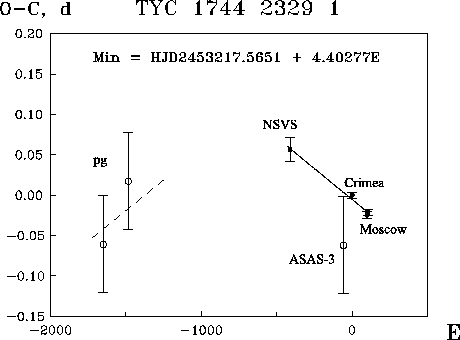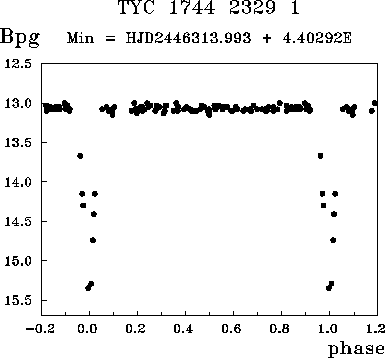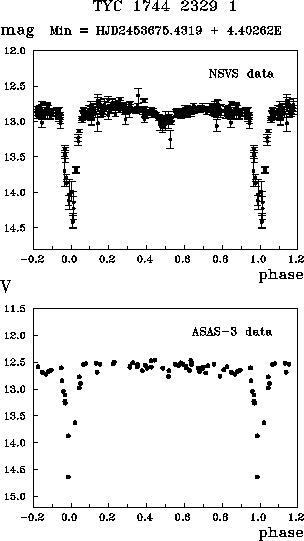|
Peremennye Zvezdy (Variable Stars) 26, No. 7, 2006 Received 14 June; accepted 20 October.
|
Article in PDF |
Period Changes in the Algol-type Eclipsing Binary System TYC 1744 2329 1
K.V. Sokolovsky1,2, S.V. Antipin1,3, S.A. Korotkiy4
- Sternberg Astronomical Institute, 13, University Ave.,
Moscow 119992, Russia
- Astro-Space Center, Lebedev
Physical Institute, Russian Academy of Sciences, Profsoyuznaya
str., 84/32, Moscow 117997, Russia
- Institute of
Astronomy, Russian Academy of Sciences, 48, Pyatnitskaya str.,
Moscow 119017, Russia
- Ka-Dar Public Observatory, Barybino, Domodedovo District, Moscow Region, Russia
| We present the discovery and the times of primary minima for the eclipsing binary TYC 1744 2329 1 = ASAS 003933+2730.5. Our CCD observations compared to times of minima derived from the archival photographic plates and from the NSVS and ASAS-3 data clearly show that the orbital period of the system is variable. |
The eclipsing binary TYC 1744 2329 1 = USNO-A2.0 1125-00240848 =
ASAS 003933+2730.5 (![]() = 0
= 0![]() 39
39![]() 33
33![]() 03,
03, ![]() =
+27
=
+27![]() 30
30![]() 29
29
![]() 3 (J2000.0)) was discovered by one of the
authors (K. Sokolovsky) on the plates of Moscow collection taken
with the 40-cm astrograph in Crimea. The star was estimated by eye
on 112 plates for the interval JD2436077-2447835. The phased
light curve for the light elements
3 (J2000.0)) was discovered by one of the
authors (K. Sokolovsky) on the plates of Moscow collection taken
with the 40-cm astrograph in Crimea. The star was estimated by eye
on 112 plates for the interval JD2436077-2447835. The phased
light curve for the light elements
is given in Fig.1. Later, the variable was independently discovered by ASAS-3 (Pojmanski, 2005). Comparison of our photographic observations to ASAS-3 and NSVS (Wozniak et al., 2004) times of minima led us to the conclusion that the
Our first CCD photometry session was carried out in 2004 July at
the 50-cm Maksutov telescope of the Crimean Laboratory (Sternberg
Astronomical Institute) equipped with a Pictor 416XTE CCD camera
with a Johnson ![]() filter. The images were dark subtracted,
flat-fielded and analyzed with the aperture photometry software
filter. The images were dark subtracted,
flat-fielded and analyzed with the aperture photometry software
![]() developed by V.P. Goranskij,
developed by V.P. Goranskij, ![]() and
and ![]() (Sokolovsky & Lebedev, 2005). Unfortunately, both night-time
minima during our observation set could be observed only partially
(Fig.3). We combined the two incomplete light curves taken on
July 17 and 30 to determine a single epoch of the primary minimum.
(Sokolovsky & Lebedev, 2005). Unfortunately, both night-time
minima during our observation set could be observed only partially
(Fig.3). We combined the two incomplete light curves taken on
July 17 and 30 to determine a single epoch of the primary minimum.
In 2005 July, we could not observe this star in Crimea because of
bad weather, so in 2005 October, we carried out one more set of
observations of the variable with the instruments of the Ka-Dar
Public Observatory located in the Moscow Region. The light minima
were observed on October 10 (the ![]() MEADE LX200GPS
Schmidt-Cassegrain Telescope and SBIG STL-6303 CCD camera with an
IR-cut filter) and on October 31 (simultaneously at the
MEADE LX200GPS
Schmidt-Cassegrain Telescope and SBIG STL-6303 CCD camera with an
IR-cut filter) and on October 31 (simultaneously at the ![]() MEADE LX200GPS Schmidt-Cassegrain Telescope equipped with an
unfilterred SBIG ST-2000XM CCD camera and at the Vixen (D = 103
mm) refractor with an unfiltered SBIG STL-6303 CCD). The
corresponding light curves are shown in Fig.4.
MEADE LX200GPS Schmidt-Cassegrain Telescope equipped with an
unfilterred SBIG ST-2000XM CCD camera and at the Vixen (D = 103
mm) refractor with an unfiltered SBIG STL-6303 CCD). The
corresponding light curves are shown in Fig.4.
Table 1. Times of primary minima and ![]() residuals.
residuals.
| HJD 24... | Error, d | Source | ||||
| 45948.531 | 0.06 | -1651 | -0.0608 | -1755 | -0.3028 | pg |
| 46679.469 | 0.06 | -1485 | 0.0173 | -1589 | -0.1997 | pg |
| 51403.6806 | 0.015 | -412 | 0.0567 | -516 | 0.0006 | NSVS |
| 52966.5451 | 0.06 | -57 | -0.0621 | -161 | -0.0650 | ASAS-3 |
| 53217.5651 | 0.004 | 0 | 0 | -104 | 0.0057 | CCD, Crimea |
| 53653.4149 | 0.004 | 99 | -0.0244 | -5 | -0.0039 | CCD, Moscow |
| 53675.4319 | 0.004 | 104 | -0.0213 | 0 | 0 | CCD, Moscow |
The times of minima derived from all available observations are
listed in Table1. The times of minima that were obtained not
from continuous observations but are individual faint points on
the phased light curve (as in the cases of photographic or ASAS-3
observations) should be considered to have an uncertainty slightly
larger than half-duration of the total eclipse (2.4 hours). The
![]() residuals in the Table were calculated for the average light
elements (linear elements for all available observations, which
are not good because of the period changes):
residuals in the Table were calculated for the average light
elements (linear elements for all available observations, which
are not good because of the period changes):
and for the current linear light elements (in excellent agreement with the NSVS, ASAS, and our CCD observations):
The
The phased light curves for the NSVS and ASAS-3 observations plotted using the current light elements are given in Fig.5.
Finally, note that the minima observed on October 9, 2005 and in July, 2004 show weak trends (decreases of brightness) during the total eclipse, while the data taken at the two Ka-Dar telescopes simultaneously on October 31, 2005 show the total eclipse to be nearly flat.
 |
Fig. 2.
The |
 |
Fig. 3. The two partially observed minima. Crimea, the 50-cm Maksutov telescope with a Pictor 416XTE CCD camera. |
 |
Fig. 4.
The two primary minima observed in 2005 at
the telescopes of the Ka-Dar observatory, Moscow region. (a)
October 10, the |
Acknowledgements: Two of the authors (K. Sokolovsky and S. Antipin) are grateful to the Russian Foundation of Basic Research (grants No. 05-02-16289 and 05-02-16688) for partial support of this study.
References:
Pojmanski, G., Pilecki, B., Szczygiel, D., 2005, AcA, 55, 275
Sokolovsky, K., Lebedev, A., 2005, in 12th Young Scientists' Conference on Astronomy and Space Physics, Kyiv, Ukraine, April 19-23, 2005, eds.: Simon, A., Golovin, A., p.79 (VAST: http://saistud.sai.msu.ru/poisk)
Wozniak, P.R., Vestrand, W.T., Akerlof, C.W. et al., 2004, Astron. J., 127, 2436

